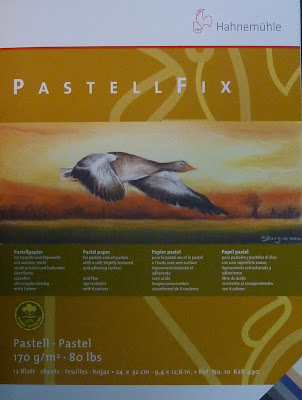 |
| 'Tangled' 12x9 pastel ©Karen Margulis available $165 |
I have a basket of unused art supplies. These are things I picked up here and there with the intent to experiment with them. I have paper, paints, sketchbooks and more. I never seem to have time to just play with these items. Today I took out a pad of paper that I got at the IAPS convention in 2017! I had never tried this paper but it looked interesting. It felt unusual....almost rubbery to the touch . But I liked how it grabbed the pastel. I am glad I had a pad of this paper so I could get to know it better.
A few Tips for Getting to Know a New Paper
- When trying any new paper or surface it is common to have a learning curve. Not all papers accept pastel in the same way.
- Don't give up on a paper after only a few tries. It takes time to get to know it. Make a commitment to paint on the new paper exclusively for a series of paintings.
- Paint something you know very well. When you are getting familiar with a new surface the last thing you want to do is have to think about new compositions, color schemes, values etc. Choose a subject you are very familiar with, one that you have painted successfully. I chose daisies. Not only was it easy to paint something I have painted many times.....it allowed me to compare the results on the new surface to my experience on other surfaces.....it was my control painitng.
 |
| Pastellfix paper |
I could only find Patellfix paper at Fineartstore online here in the US. Here is some more information:
170 gsm, cotton rag content
PastellFix offers artists an incomparable painting experience. You can feel how different it is from other pastel papers straight away. "The velvety looking surface is a totally new haptic experience and your chalk pastels seem to just dance across it. Working with this high quality paper is thoroughly enjoyable right from the start," says artist Monika Mori enthusiastically.
Pastel pigments dissolve quickly and without the application of any undue pressure on the soft, slightly textured paper. The colour pigments adhere beautifully to the surface, where they settle gently but firmly. Blurred lines and carefully nuanced shading can easily be created with different wiping techniques. Developed especially for pastels, 170 g/m² PastellFix paper is also perfect for oil pastel, pencil, sanguine or charcoal works. The pastel painting pad contains two sheets of each of the following colours: ivory, sand, navy, steel grey, dark grey and black. The different shades are protected by transparent dividers. This paper offers professional as well as hobby artists the perfect surface for giving free rein to their creativity. The acid free paper has a cotton rag content and is felt marked.
Pastel pigments dissolve quickly and without the application of any undue pressure on the soft, slightly textured paper. The colour pigments adhere beautifully to the surface, where they settle gently but firmly. Blurred lines and carefully nuanced shading can easily be created with different wiping techniques. Developed especially for pastels, 170 g/m² PastellFix paper is also perfect for oil pastel, pencil, sanguine or charcoal works. The pastel painting pad contains two sheets of each of the following colours: ivory, sand, navy, steel grey, dark grey and black. The different shades are protected by transparent dividers. This paper offers professional as well as hobby artists the perfect surface for giving free rein to their creativity. The acid free paper has a cotton rag content and is felt marked.
 |
| I chose an orange toned piece of paper form the pad |
 |
| The first layers |

2 comments:
Thank you Karen. I noticed this yesterday when I got Pastelmat paper, new to me. I had only used sanded paper that can withstand hard handling. Pastelmat took some work before I was happy.
Tuija Granqvist
This is a good message. I’m feeling a bit frustrated with sabourtooth and I’ve packed a lot of it so I’m going to keep practicing on it!
Post a Comment